Bridges are an incredible engineering feat – the ability to connect two different land masses is no small task. Every single day, bridges are in use for public transit, to help deliver products and goods, or to cross a large body of water. They are a lot more beneficial than we realize because of all of these reasons and more.
The state of New South Wales in Australia has a variety of bridges. There are railway bridges, pedestrian bridges, and other bridges that simply allow people to cross a body of water or land. In this context, the largest bridge’s length defines it as the largest. So, while there are a lot of tall bridges in New South Wales, in this article, we measure the bridges by their length.
12. Pyrmont Bridge
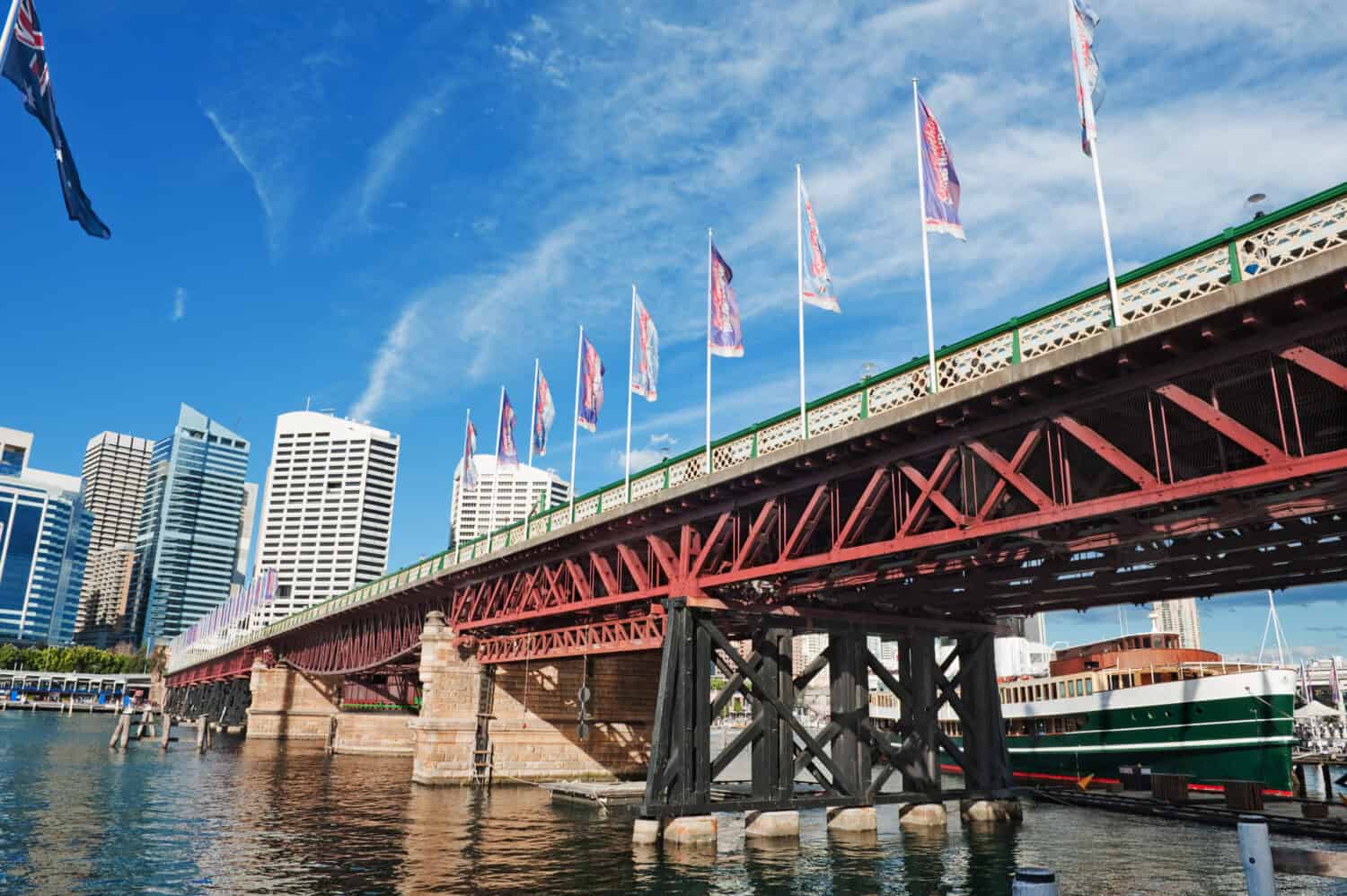
The Pyrmont Bridge is a swing bridge that towers over Darling Harbor in Sydney.
©Lev Kropotov/Shutterstock.com
To start, the Pyrmont Bridge is the twelfth-largest bridge in New South Wales. It is 1,211 feet long. The Pyrmont Bridge is a swing bridge, which means that it is a movable bridge. However, unlike a drawbridge, it swings away from the different areas of land that it’s connecting to allow ships to pass.
The bridge is located in Darling Harbor in Sydney, and it allows pedestrians to cross Cockle Bay. It is also a National Engineering Landmark, recognized by Engineers Australia.
The Pyrmont Bridge Company opened the original Pyrmont Bridge in 1858. Now owned and maintained by the Sydney Harbour Foreshore Authority, the current bridge has been in operation since 1902. Additionally, with motor vehicles diverted to the freeways nearby, the Pyrmont Bridge has been a foot-traffic- and bike-traffic-only bridge since 1981. It’s now a part of the New South Wales State Heritage Register, because of its historic and scientific significance. Its location allowed for the economic growth of Sydney in the 19th century, as it was able to connect the western suburbs and the city.
11. Sea Cliff Bridge
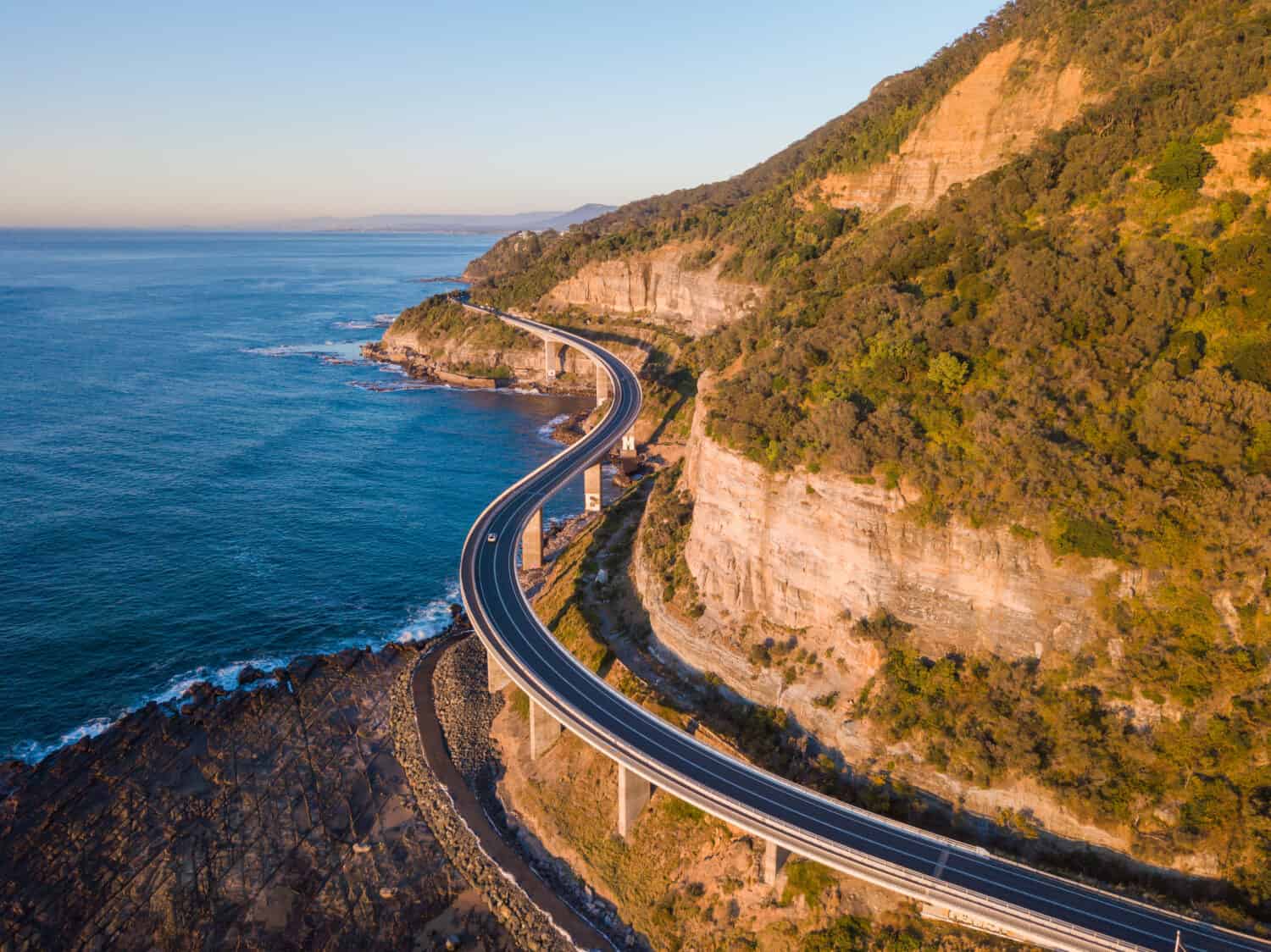
The Sea Cliff Bridge connects Coalcliff and Clifton, two small towns in New South Wales.
©aiyoshi597/Shutterstock.com
The Sea Cliff Bridge is 1,495 feet long and connects the small towns of Coalcliff and Clifton. The bridge, along with the Lawrence Hargrave Drive Bridge, carries the picturesque Lawrence Hargrave Drive. It crosses the rockway at the Illawarra escarpment and the Tasman Sea below it. The Sea Cliff Bridge allows two lanes of motor vehicle traffic, as well as bicycles and pedestrians.
A consistent amount of rock falls that struck portions of the road brought about the closure of Lawrence Hargrave Drive in August 2003. However, residents of the area advocated for something to replace the stretch. This route was an important passageway from the northern suburbs of Wollongong to Coalcliff, Otford, and other surrounding cities. The Sea Cliff Bridge, which saw completion in December 2005, replaced this section.
Fun fact: in a local contest with schools in the area, 11-year-old Makenzie Russell named the Sea Cliff Bridge.
10. Mooney Mooney Bridge
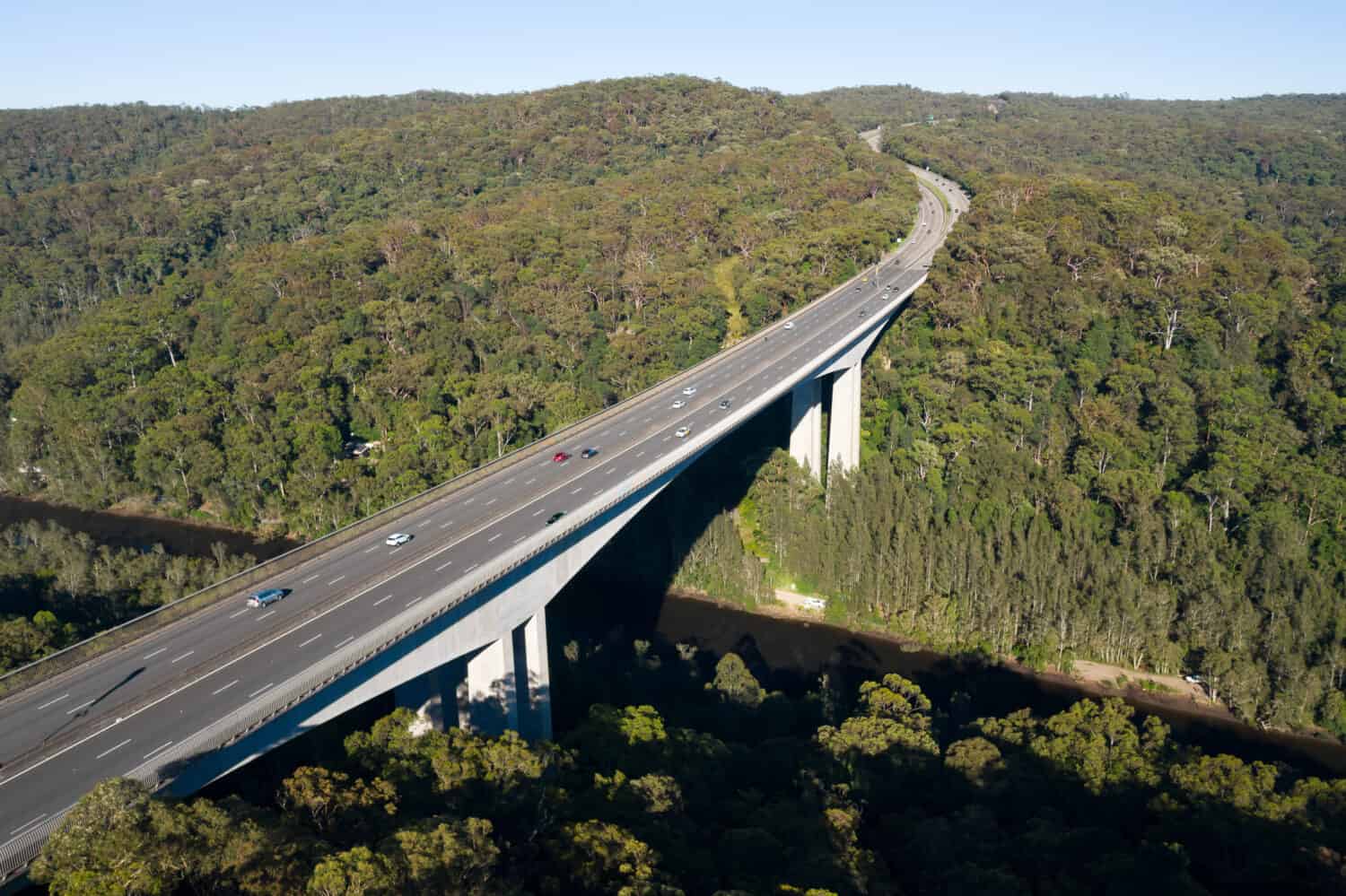
The Mooney Mooney Bridge crosses Mooney Mooney Creek, carrying the M1.
©Harley Kingston/Shutterstock.com
Officially known as the Mooney Mooney Creek Bridge and also known as the NSW Big Dipper Bridge, this bridge is the tenth-largest bridge in New South Wales. It is 1,575 feet long and crosses Mooney Mooney Creek. Mooney Mooney Bridge is the main road connection between Sydney, the Central Coast, and the Hunter Region. It opened in 1986 and carries the Pacific Motorway, or the M1. Only motor vehicles are able to cross this concrete box girder bridge.
Additionally, the Mooney Mooney Bridge is also an incredibly tall bridge, reaching 246 feet at its tallest.
This bridge was the solution to the fact that the original 1930 steel two-lane bridge couldn’t hold all the traffic that came through the region. Transport for NSW, a New South Wales government transport and road agency, now owns and operates Mooney Mooney Bridge.
9. Gladesville Bridge
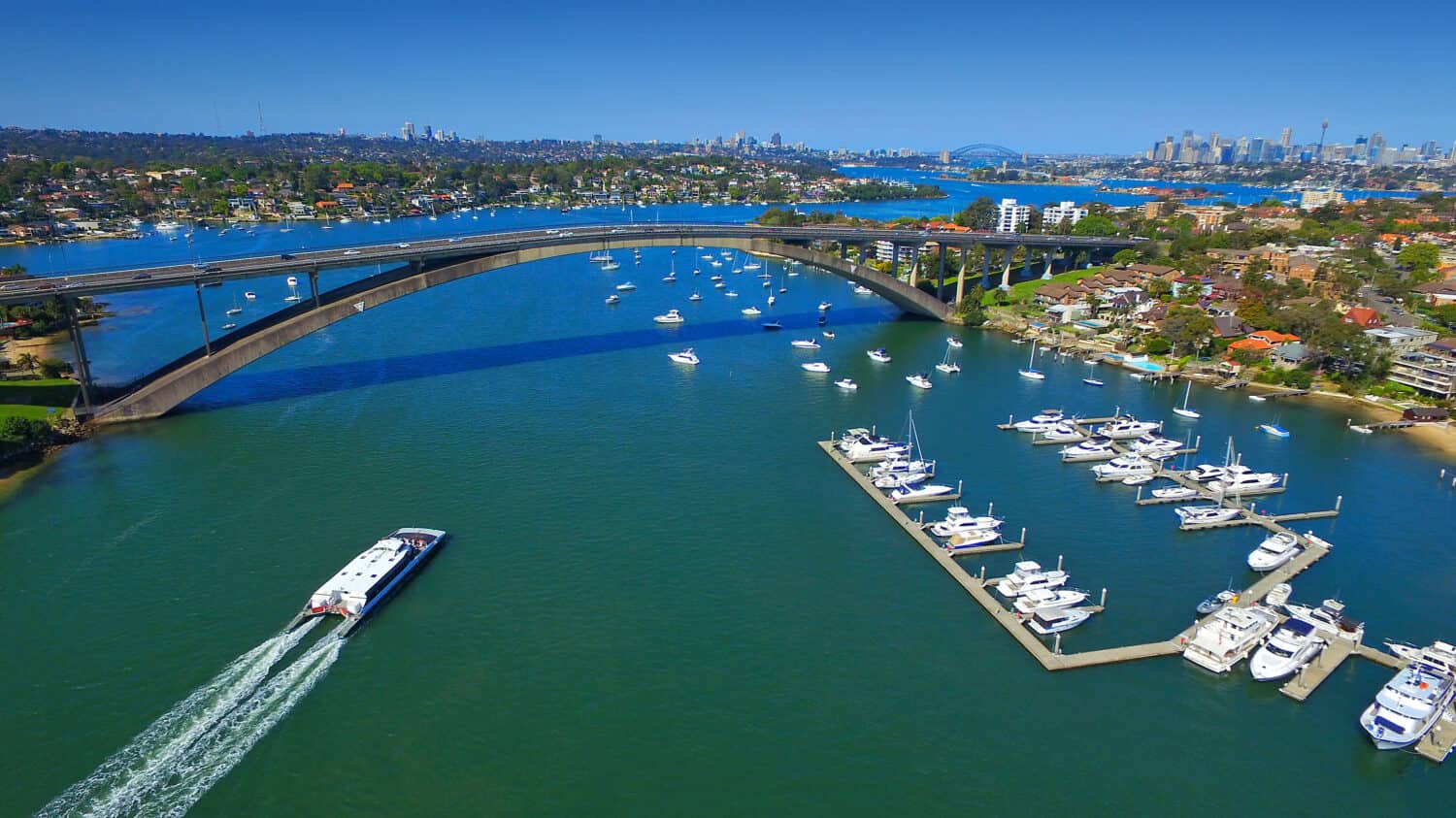
Gladesville Bridge is located just upstream of the Sydney Harbor Bridge.
©Hypervision Creative/Shutterstock.com
The ninth-largest bridge in New South Wales is Gladesville Bridge, located in the suburbs of Sydney. It is a 1,901-foot-long concrete arch bridge that connects two of Sydney’s suburbs: Huntleys Point and Drummoyne. This bridge carries the A40, also known as Victoria Road, and carries motor vehicles and allows space for pedestrians and cyclists to also cross it safely.
Originally, the Gladesville Bridge was built in 1881, and allowed only motorists to cross the bridge. However, it became quickly congested in the 1950s as private car ownership became more common and resulted in the need for a larger, more sustainable way to cross the Parramatta River. In 1964, the newly improved Gladesville Bridge was opened and is now owned and currently maintained by Transport for NSW.
8. Hawkesbury River Railway Bridge

The Hawkesbury River railway bridge is located just outside of Sydney.
©Jason Vanajek/Shutterstock.com
Next, the eighth-largest bridge in New South Wales is the Hawkesbury River railway bridge. It’s located just north of Brooklyn, a town in New South Wales just outside of Sydney. This railway bridge is 2,575 feet long, and it carries the Main Northern railway line. It crosses the Hawkesbury River and connects Brooklyn to Cogra Bay, a suburb of the Central Coast.
This engineering feat was designed to be a railway link between Adelaide, Sydney, Melbourne, and Brisbane, or the state capitals. Originally built in 1889, it was replaced in 1946 because of the increased demands on the first one. Traffic and transport increased during World War I, and so another bridge was designed and built, as fears arose that the old bridge would not be able to withstand the increased traffic. The eight-truss railway bridge is still standing as a railway bridge.
7. Anzac Bridge
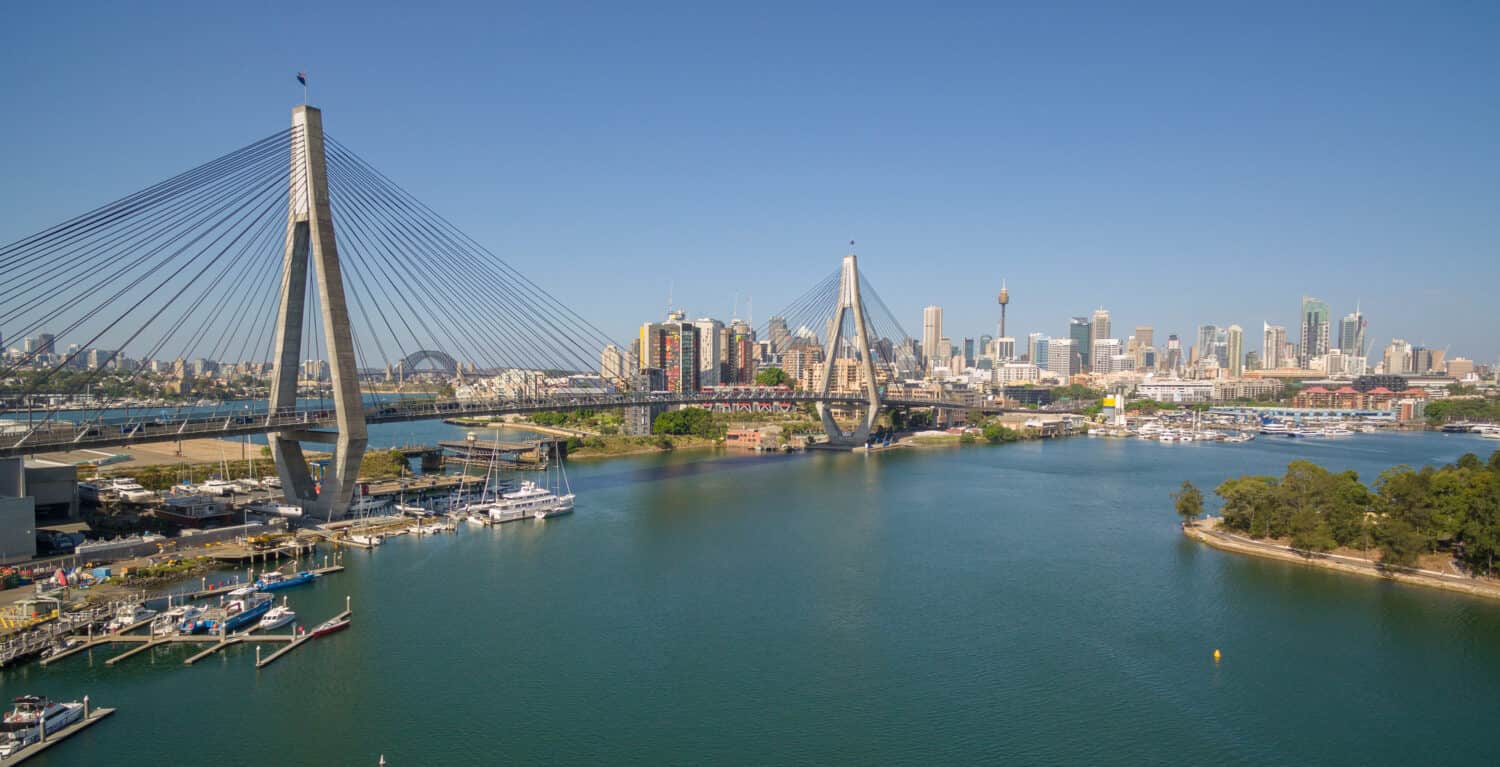
The Anzac Bridge is a cable-stayed bridge that crosses over Johnstons Bay.
©Geraldo Sansone/Shutterstock.com
The Anzac Bridge is the seventh-largest bridge in New South Wales, located in the capital of Sydney. It is 2,641 feet long and crosses Johnstons Bay. The Anzac Bridge carries the Western Distributor (A4), a motorway in western Sydney, in the Sydney central business district. It connects the suburb of Pyrmont in the east to Glebe Island, part of the Rozelle suburb, in the west. The bridge is of a cable-stayed design, which means that it has one or more towers that run cables to the bridge deck in order to support it.
It opened to motorists, cyclists, and pedestrians in 1995, originally as the Glebe Island Bridge. After that, it was renamed in 1998 to the Anzac Bridge. The term Anzac describes a soldier in the Australian and New Zealand Army Corps (ANZAC) who served in the First World War. Transport for NSW now owns and operates the bridge.
6. Harwood Bridge
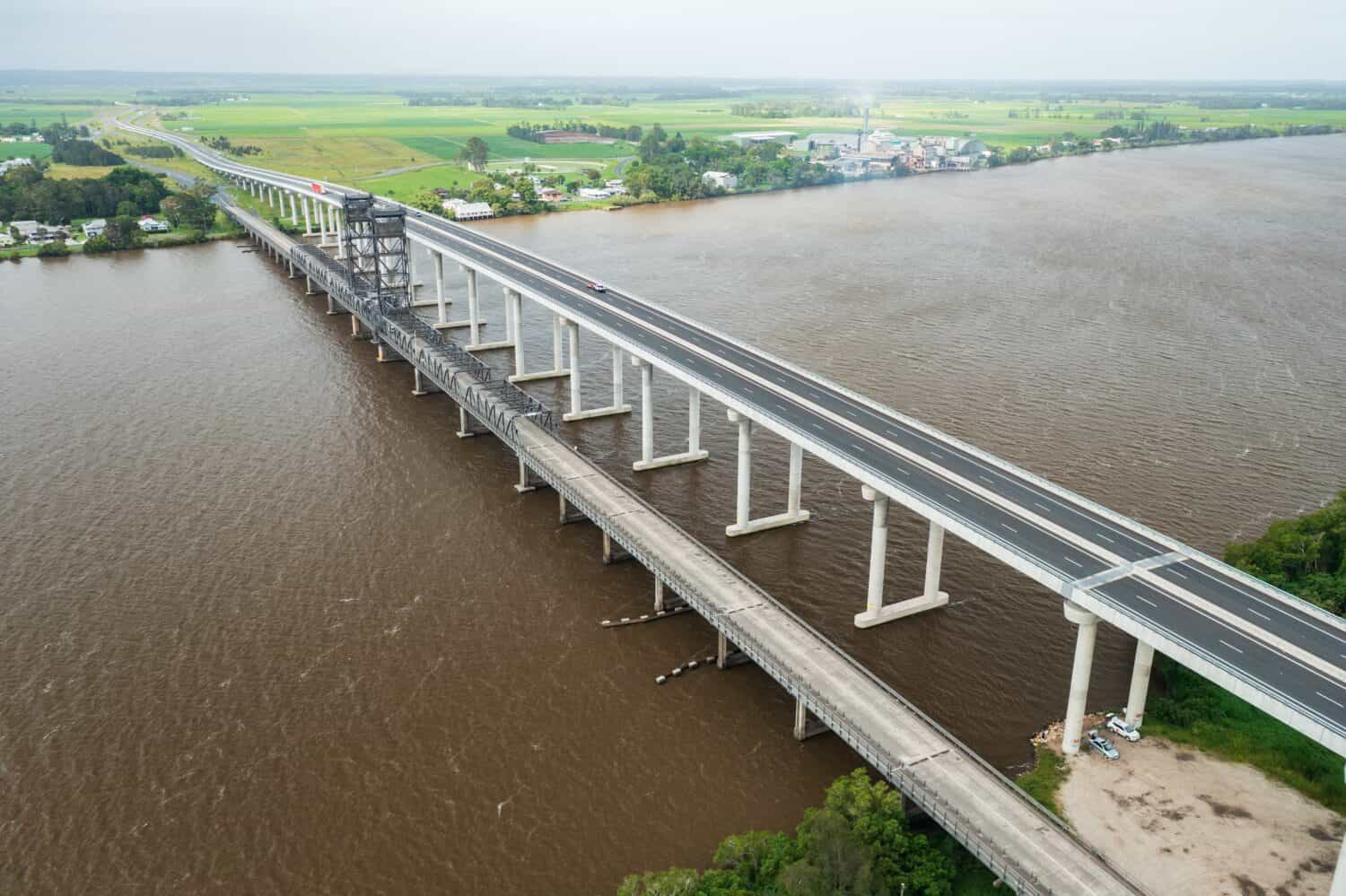
The Harwood Bridge stands next to the old bridge.
©Harley Kingston/Shutterstock.com
The Harwood Bridge spans 2,913 feet over the Clarence River and is the sixth-largest bridge in New South Wales. It stands tall in Maclean, a city that’s about 400 miles from Sydney. From 1966 until 2019, it carried the Pacific Highway (A1) across the Clarence River. However, when the Pacific Highway between Grafton and Ballina — two cities along the A1 — received improvements, the bridge became defunct. Now, it still stands as a way to access Harwood Island, its namesake.
The Harwood Bridge is a two-lane motorway that can transport cars in addition to cyclists and pedestrians. It is a steel truss bridge that contains seven trusses and twenty-seven girders. Ships are still able to pass through underneath due to one of the steel truss spans being a vertical lift span. Transport for NSW now maintains it.
5. Prince Alfred Bridge
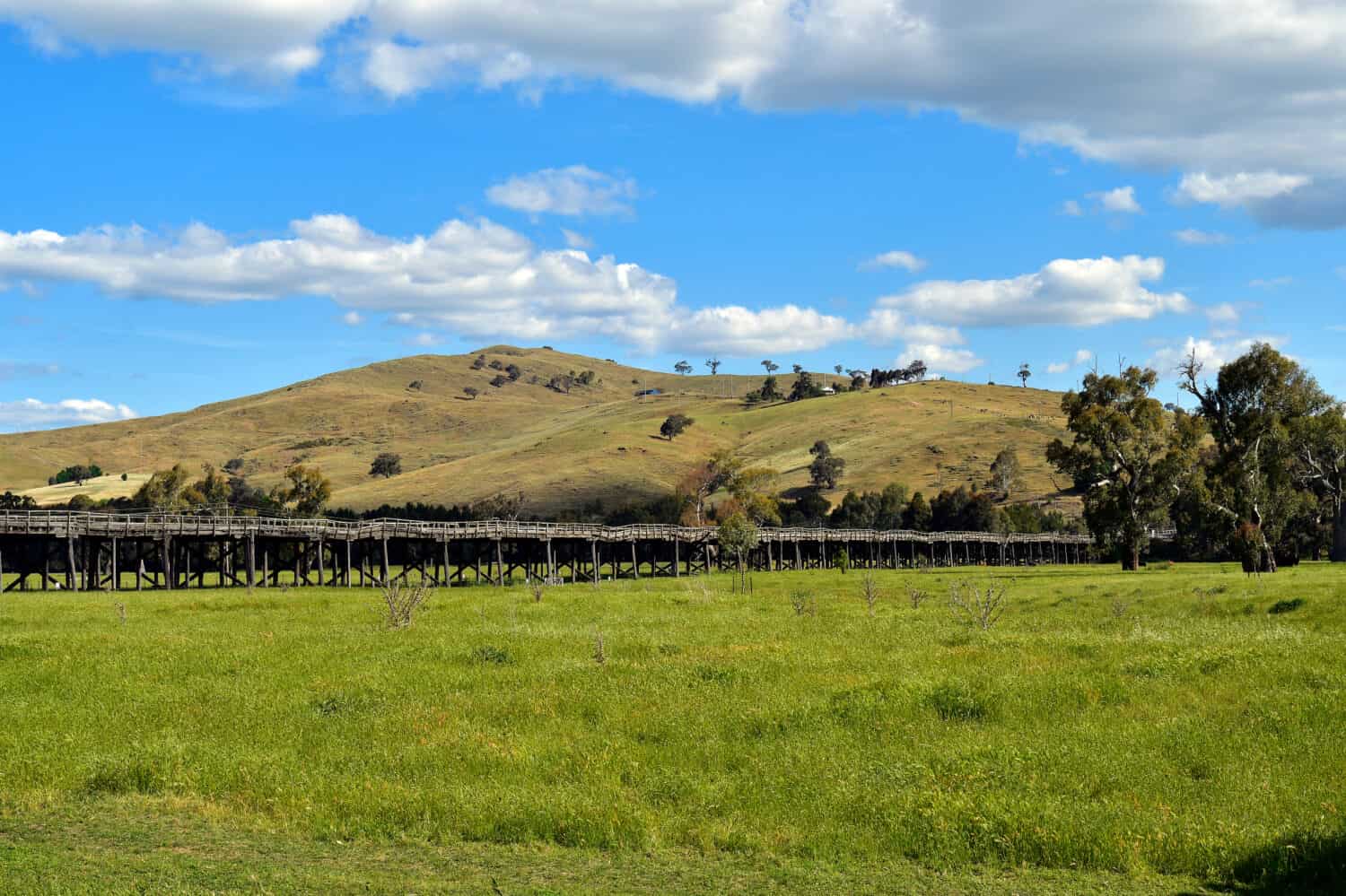
The historic Prince Alfred Bridge is the longest wooden bridge in Australia.
©fritz16/Shutterstock.com
The now semi-defunct Prince Alfred Bridge spans 3,025 feet across the Murrumbidgee River at Middleton Drive, Gundagai, Cootamundra-Gundagai Regional Council, in New South Wales. It is a partial timber beam and wrought iron truss bridge and only serves local traffic now in certain parts of the bridge. The Prince Alfred Bridge is an incredibly old bridge, built between 1864 and 1867. The timber viaduct portion of the bridge is now unusable as it has deteriorated and is unsafe for motorists and pedestrians. However, the iron portion of the bridge is still in use to this day.
It is named for the then-reigning Queen Victoria’s son Prince Alfred and is the first iron truss bridge to be built in New South Wales. Originally, it was the main way to cross the Murrumbidgee River via the Hume Highway. However, the Sheahan Bridge replaced it in 1977, as the conditions of the Prince Alfred Bridge worsened and made it unsafe to utilize.
4. Stockton Bridge
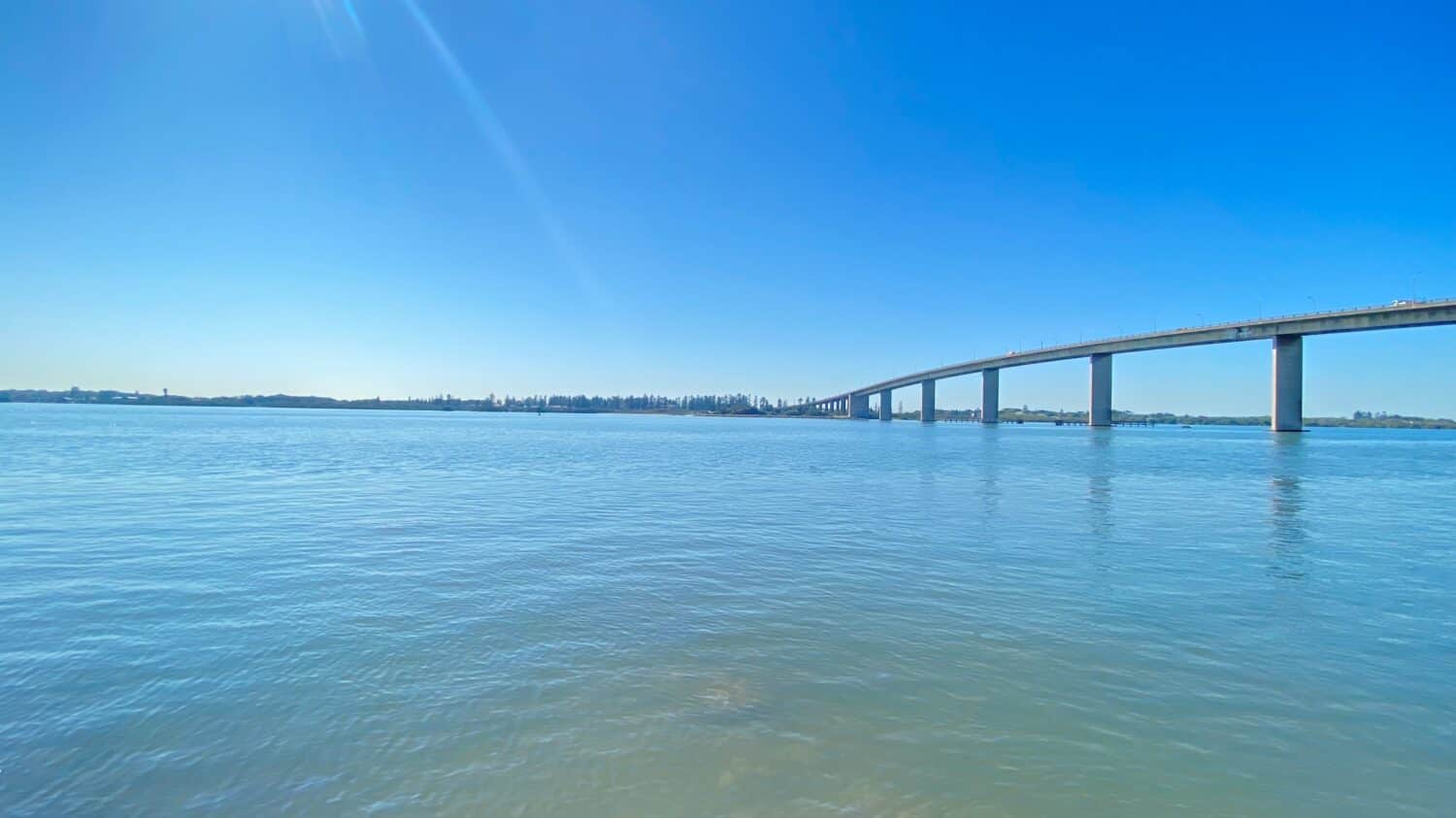
The Stockton Bridge is located in the Hunter Region of New South Wales.
©IBRAHIM AL KHALIL/Shutterstock.com
Next on the largest bridges in New South Wales list comes the Stockton Bridge. This bridge is located in the Hunter Region of New South Wales. It is 3,360 feet long and crosses over the Hunter River and carries the Nelson Bay Road. The Stockton Bridge runs from Stockton to Kooragang and is the main transport route for the region. Named for the suburb of Stockton, the bridge connects Newcastle and the Tilligerry and Tomaree peninsulas.
This concrete arch bridge carries motorists, cyclists, and pedestrians. Transport for NSW now owns it, and the Newcastle City Council maintains it. Before the construction of the bridge, there was a car ferry service that allowed citizens of Newcastle and Stockton to cross the Hunter River. Construction began on the Stockton Bridge in 1968 after years of debate about the best way to cross the river. Different bridges were designed but most were rejected because they were either not feasible or would interfere with shipping. In fact, one of the suggestions was for an underwater tunnel, which the Newcastle Harbour Crossing Committee rejected. Finally, the Stockton Bridge was approved as its height allowed for the shipping lane to continue underneath it.
3. Sheahan Bridge

The Sheahan Bridge replaced the Prince Alfred Bridge because of its rapid deterioration.
The Sheahan Bridge is the replacement bridge for the Prince Alfred Bridge. At 3,743 feet long the Sheahan Bridge carries the Hume Highway over the Murrumbidgee River in New South Wales. It was named after Australian politician Bill Sheahan. It opened in 1977 and initially carried traffic both northbound and southbound. However, with increased traffic, a second bridge was built parallel to the Sheahan Bridge. This allowed the original bridge to carry northbound traffic in both lanes. The duplicate bridge has been carrying southbound traffic from 2009 on.
2. Sydney Harbor Bridge

The Sydney Harbor Bridge is the world’s tallest steel arch bridge.
©anek.soowannaphoom/Shutterstock.com
Next on the largest bridges in Australia is the Sydney Harbor Bridge. This bridge is 3,769 feet long and crosses Port Jackson in Sydney Harbor. It spans from the central business district, or the CBD, to the North Shore. The Sydney Harbor Bridge is one of Australia’s more iconic landmarks, as you see it with the Sydney Opera House and the harbor often all together in pictures. This bridge carries pedestrians, cyclists, and motor vehicles, in addition to the rail system.
Construction on the Sydney Harbor Bridge began in 1923, and it opened to the public in 1932. It has the nickname “The Coathanger” because of its iconic arch, which was based on the Hell Gate Bridge in New York City. Moreover, it is also the world’s tallest steel arch bridge. From the top of the arch to the water level below it, it stands at 440 feet tall.
The Sydney Harbor Bridge was conceptualized in 1814. Renowned architect Francis Greenway had supposedly suggested to then-governer Lachlan Macquarie that there should be a bridge that connects the North and South shores of the harbor. Nothing came to fruition though, until John Bradfield came along with a vision. With a passion for seeing the bridge completed, Bradfield secured financing and planning for the bridge. Eventually, after almost a decade of construction, the Sydney Harbor Bridge opened to the public. It now stands as a popular tourist destination and an everyday sight for Sydneysiders.
1. Macleay Valley Bridge
The largest bridge in New South Wales is the Macleay Valley Bridge at a staggering 10,500 feet long. It crosses over the Macleay River and its surrounding floodplain. It is located near the town of Frederickton, about 300 miles from Sydney. This bridge carries the Pacific Highway’s (A1) new alignment, which bypasses Frederickton and Kempsey.
The Macleay Valley Bridge has many different names. It also has the name Macleay River Bridge and the Macleay River and Floodplain Bridge, for the region it crosses. Additionally, it’s also known as the Yapang gurraarrbang gayanddugayigu, at the request of the indigenous Djangadi people. The name means “very long track to the other side” in the Dhanggati language, the language spoken by the Djangadi people. Finally, it was named Macleay Valley Bridge in 2015, and it was also given the secondary name Yapang gurraarrbang gayanddugayigu.
The Macleay Valley Bridge is a girder bridge that is composed of 941 concrete beams and 93 piers. It was opened to the public in 2013, and is used by motor vehicles only. There are four total lanes of traffic, with two lanes running in either direction.
In conclusion, the largest bridges in New South Wales are defined by their length. The Macleay Valley Bridge is the largest bridge in the state, spanning 10,500 feet.
| RANK | NAME OF BRIDGE | LENGTH (IN FEET) |
| 11 | Pyrmont Bridge | 1,211 ft. |
| 10 | Sea Cliff Bridge | 1,495 ft. |
| 9 | Mooney Mooney Creek Bridge | 1,575 ft. |
| 8 | Hawkesbury River railway bridge | 2,575 ft. |
| 7 | Anzac Bridge | 2,641 ft. |
| 6 | Harwood Bridge | 2,913 ft. |
| 5 | Prince Alfred Bridge | 3,025 ft. |
| 4 | Stockton Bridge | 3,360 ft. |
| 3 | Sheahan Bridge | 3,743 ft. |
| 2 | Sydney Harbor Bridge | 3,769 ft. |
| 1 | Macleay Valley Bridge | 10,500 ft. |
Thank you for reading! Have some feedback for us? Contact the AZ Animals editorial team.








